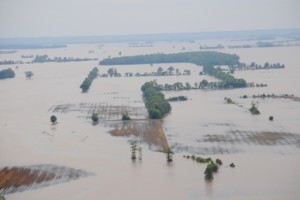Flood Problems Linger as Waters Recede

Located just 45 miles north of I-10 in rural Louisiana, in a town just off the western banks of the Mississippi River, George LaCour’s farm has seen just about every type of weather-related setback this season.
The Batchelor, LA, grower intended to plant over 3,000 acres of corn, soybeans and cotton in 2011, just as prices were making each crop attractive. But on a day in early June when LaCour should have been tending to a young crop, he instead was forced to sit idly by, as thousands of his acres lay under water and thousands more remained bone dry.
“We’re just sitting here sitting on our hands, because we can’t even plant our fields that aren’t under water. We’ve had a drought down here. We haven’t had a rain in a couple of months,” says LaCour, who now finds himself wishing for rain to fall while simultaneously wanting the flood waters to recede.
As extraordinary as LaCour’s plight is, countless other producers share in his dilemma up and down the Mississippi River, in the Mid-South’s most concentrated cotton producing region. Heavy April storms in the upper Mid-South and throughout the Mississippi River’s drainage network helped create a volume of water in the Mississippi River basin that set flood-stage records in Missouri, Arkansas, Tennessee, Mississippi and Louisiana.
For LaCour and other farmers in his region of Louisiana, severe natural flooding began in late April.
“I went home on Good Friday and everything was fine. I came back on Monday morning and everything had gone to hell. One day falls into the next after that,” says LaCour. He eventually lost 1,000 acres to the flood, and that was before the Army Corps of Engineers opened the Morganza Spillway on May 14, effectively flooding thousands more of his acres for the remainder of the summer. LaCour says the decision to open the spillway was necessary to save his home.
“By the time the water got to us, it wasn’t going to be just another ‘high water’. It was going to be the highest water on record. So by that time, we were already thinking about trying to save our homes. So there wasn’t any conflict or controversy over opening the spillway because we know that’s the way the system works,” he says.
But 500 miles upstream, in New Madrid, MO, a different set of circumstances surrounded the opening of another floodway. As the Corps of Engineers prepared to blow the Birds Point Levee in early May, Missouri legislators stepped in on behalf of the growers who would be impacted by flooding approximately 130,000 acres of farmland located in the floodway.
Despite strong opposition from U.S. Representative Jo Ann Emerson (R-MO) and U.S. Senator Roy Blunt (R-MO), among others, the Corps of Engineers ultimately blew the levee on May 2, leaving many Missouri cotton acres underwater.
“Our actual shop is dry, but we have 800 acres that are in the floodway right now, up under water. I would say 500 of that would have been cotton,” says Chris Wescoat, who farms with his father near New Madrid, MO.
Like LaCour, Wescoat is resigned to the fact that he won’t be able to plant anything on much of his acreage this year.
“The problem with getting a crop in is this – when will it get dry? Our season is short here. Not incredibly short, but it’s shorter than most. The chances for an early frost for us are a lot higher than for most people. Even our bean crops, it’s going to be so late when this ground gets ready, if it gets ready at all,” says Wescoat.
This story is excerpted from a coming feature in the July 2011 edition of Cotton Grower magazine.









